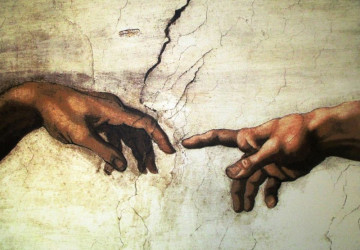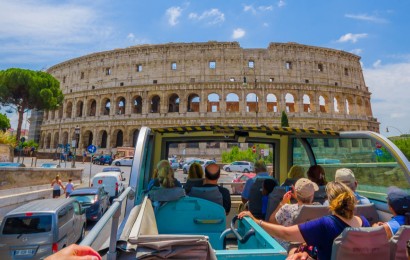The Sistine Chapel is one of the most celebrated places in the world, not only for its artistic beauty but also for the role it plays in the history and life of the Catholic Church. Every year, millions of visitors are left breathless in front of its frescoes, often unaware of the many curiosities that make this place unique. In this article, we’ll uncover lesser-known details: from its precise location, to the popes who commissioned it, and the artists who helped transform it into an immortal masterpiece.
Where is the Sistine Chapel located?
The Sistine Chapel is located inside the Vatican Museums, in Vatican City, just a few steps away from St. Peter’s Basilica. Although it is often referred to as a “chapel” as if it were a stand-alone building, in reality it is an integral part of the museum route. Its position is strategic: located near the papal apartments and other reception halls, it was conceived from the very beginning both as the Pope’s private chapel and as a venue for solemn ceremonies.
Entering the Sistine Chapel means walking through one of the most fascinating paths of the Vatican Museums, an itinerary that guides visitors through rooms filled with art, leading to what many consider the beating heart of the entire museum complex.
Which Pope Commissioned the Sistine Chapel?
The Sistine Chapel takes its name from Pope Sixtus IV della Rovere, who strongly desired its construction in the second half of the 15th century. His goal was twofold: to provide the Vatican with a larger and more majestic private chapel, and to create a suitable space for the solemn ceremonies of the Roman Curia.
Construction began in 1477 and was completed in 1481, under the direction of architect Baccio Pontelli. Pope Sixtus IV entrusted the first pictorial decorations to a group of Tuscan and Umbrian artists, including Botticelli, Perugino, Ghirlandaio, and Pinturicchio. These masters created the frescoes on the side walls, depicting episodes from the lives of Moses and Christ, in a refined parallelism that connects the Old and New Testaments.
What do cardinals do in the Sistine Chapel?
One of the aspects that makes the Sistine Chapel world-famous is the conclave, the assembly of cardinals gathered to elect a new Pope. Whenever the papal seat becomes vacant, the cardinal electors are locked inside the Sistine Chapel until the final decision is reached.
During the conclave, the cardinals pray, discuss, and vote, following an ancient and solemn ritual. The Chapel thus becomes the stage for one of the most significant moments for the Catholic Church. Voting takes place several times a day, and the outcome is communicated to the world through the famous smoke signal: black if no decision has been made, white if a new pontiff has been chosen.
Where is the Room of Tears?
Next to the Sistine Chapel lies a small chamber known as the Room of Tears. This lesser-known place holds deep symbolic meaning. It is here that the new Pope withdraws immediately after election, to don the white cassock for the first time and collect himself in prayer.
The name “Room of Tears” comes from the emotions that traditionally overwhelm the newly elected Popes in that moment: the combination of deep emotion and the awareness of such immense responsibility often leads to tears. This intimate space thus becomes the bridge between the conclave’s secret decision and the Pope’s first public appearance in St. Peter’s Square.
What does the Pope do in the "Room of Tears"?
In the Room of Tears, the Pope performs his first gestures as pontiff: he puts on the white cassock, symbolizing purity and apostolic continuity, and chooses whether to stop and pray in silence or follow the guidance of the papal masters of ceremonies.
It is also here that he is offered three different sizes of the papal cassock, prepared in advance to suit the newly elected. Only after these steps does the Pope leave the Sistine Chapel to present himself to the world with the traditional announcement, “Habemus Papam.”
Who painted the Sistine Chapel in Rome?
When it comes to who painted the Sistine Chapel, the answer is not a simple one. While the side walls were entrusted to Renaissance masters such as Botticelli, Perugino, and Ghirlandaio, it was Michelangelo Buonarroti who rendered the chapel immortal with his works on the ceiling and the Last Judgment. The combination of so many artists makes the Sistine Chapel a collective masterpiece, but Michelangelo’s imprint remains the most recognizable and imposing.
How long did it take Michelangelo to paint the Sistine Chapel?
Michelangelo took about four years to complete the ceiling of the Sistine Chapel, from 1508 to 1512. Initially reluctant to accept the task, considering himself more a sculptor than a painter, he eventually accepted the challenge proposed by Pope Julius II. He worked under extremely harsh conditions: often lying on scaffolding, with paint dripping on his face, and his body strained by immense physical effort.
The result, however, was extraordinary: over 500 figures in a cycle of frescoes depicting episodes from Genesis, from the Creation of Adam to the Great Flood. A work that forever changed the course of art history.
What did Raphael do in the Sistine Chapel?
Raphael did not paint directly inside the Sistine Chapel, but he played an important role in the Vatican’s artistic environment of the time. His contribution to the Sistine Chapel mainly concerned the cartoons for the tapestries that once decorated the lower walls of the chapel. Commissioned by Pope Leo X, these tapestries depicted scenes from the Acts of the Apostles and were woven in Brussels.
Although less known to the general public than Michelangelo’s ceiling, these tapestries enriched the chapel further and testify to Raphael’s significance in the artistic panorama of Renaissance Rome.
Who painted the Last Supper in the Sistine Chapel?
A curiosity that surprises many visitors concerns the Last Supper: it is not found in the Sistine Chapel. The most famous Last Supper, painted by Leonardo da Vinci, is preserved in Milan, in the refectory of Santa Maria delle Grazie. The Sistine Chapel does not contain a fresco depicting this subject.
The confusion arises from the fact that the chapel houses numerous biblical scenes, but not that of the Last Supper of Christ with the Apostles. This detail is often cited as one of the lesser-known curiosities about the chapel.
Which artist painted the Last Judgment in the Sistine Chapel?
The Last Judgment is one of Michelangelo’s greatest masterpieces, painted many years after the ceiling, between 1536 and 1541, commissioned first by Pope Clement VII and later by Paul III Farnese. The artist depicted the final moment of humanity’s history, with Christ the Judge at the center and, around him, the resurrected souls rising to Paradise or being dragged into Hell.
The Last Judgment caused great uproar for its abundance of nude figures, considered excessively daring for the time. Later, some were covered with painted draperies, but the overall impact of the work remained intact: a whirlwind of bodies and emotions that still leaves visitors astonished today.
What is the best way to visit the Sistine Chapel?
Visiting the Sistine Chapel is an experience that should be planned carefully, both to avoid long waits and to fully appreciate its beauty. The route lies at the end of the Vatican Museums, and without an expert guide, many important details along the way may be overlooked.
The best way to reach the Sistine Chapel is to rely on comfortable, direct transportation to the heart of Rome. The open-top buses by Green Line Tours connect the city’s main landmarks and make it easy to get to the Vatican Museums, avoiding the stress of traffic and parking.
Once there, the best choice is to book a Vatican tour. This way you can not only admire the Sistine Chapel but also understand the richness of the collections, the secrets of the Raphael Rooms, and the grandeur of St. Peter’s Basilica. With priority access and an expert guide, the experience becomes complete and unforgettable.
Book your Vatican tour with Green Line Tours and enjoy the Sistine Chapel without waiting, with the convenience of dedicated transportation and the expertise of those who know Rome best.

